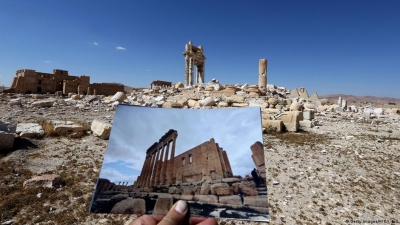What world heritage sites have been destroyed by war?

Over 160 Ukrainian cultural sites have been damaged or destroyed since the Russian invasion of the country began this February, according to UNESCO. Ukraine is home to seven UNESCO World Heritage sites. As many of these stand threatened today, here's a glimpse of such sites that have been damaged or destroyed due to war in other parts of the world.
Palmyra and Aleppo, Syria
During the 2015 civil war in Syria, the Islamic State of Iraq and Syria (ISIS) destroyed several parts of Palmyra, including many important archaeological sites such as the Temple of Baalshamin, Monumental Arch, and Tower of Elahbel. After their expulsion from the heritage site, Syrian forces began work on restoring the destroyed parts. The war also damaged many cultural and other heritage sites in Aleppo, one of the oldest Syrian cities. This includes the Citadel, a UNESCO World Heritage Site. The castle was one of the world's largest and oldest dating back to the 3rd millennium BC. Another site destroyed was The Great Mosque of Aleppo that contained the remains of Zechariah, the father of John the Baptist. Minaret of the central Umayyad Mosque, about 60% of the covered marketplace (souk), and ancient houses from the 1st Century AD were also destroyed during the war.
Jonah's Tomb, Iraq
Jonah's Tomb, also known as The Mosque of the Prophet Younis, considered to be the final resting place of the biblical Prophet and one of the important religious sites for both Christians and Muslims, was blown up by the ISIS in 2014. The group claimed it was done to protest against the mosque, which was not a prayer area anymore.
Timbuktu's religious sites, Africa
In 2012, a Malian militant destroyed several religious and historical buildings in Timbuktu, including tombs and mausoleums of Sufi saints, medieval shrines, and the 15th-Century Sidi Yahya mosque. According to UNESCO, 14 of Timbuktu's destroyed mausoleums were rebuilt by 2015. However, Timbuktu has been listed as an endangered World Heritage Site due to the ongoing armed conflict in the region.
Buddhas of Bamiyan, Afghanistan
Built under the Gandhara School of Art, the Buddhas of Bamiyan were the tallest standing statues in the world. They were blown into pieces in 2001 by the Taliban. One of the statues was 180 feet tall. The twin Buddha figurines were located on the ancient Silk Road. Though several attempts were made to restore the statues, reinstallation of the monuments could not be done due to disputes over the materials to be used.
Former Prefectural Industrial Promotion Hall, Japan
In 1945, the U.S. Air Force's atomic bomb that targeted Hiroshima destroyed parts of the former Prefectural Industrial Promotion Hall. Constructed in 1915, it was designed by Czech architect Jan Letzel. The remains of the Hall-A-Bomb Dome - are now part of the Hiroshima Peace Memorial Park. It was included in the UNESCO World Heritage Sites list in 1996.
Malta's Royal Opera House, Valletta
Designed by English architect Edward Middleton Barry and inaugurated in 1866, the Royal Opera House was destroyed by the bombs of Germany's Air Force during World War II in 1942. After several attempts to reconstruct the theatre, an open-air theatre called Pjazza Teatru Rjal was built amid the Royal Opera House ruins in 2013.
St. Michael's Old Cathedral, the U.K.
Another UNESCO World Heritage Site destroyed during World War II was St. Michael's Old Cathedral. The Gothic church was built between the late 14th and early 15th Centuries in Coventry. The 'new cathedral' representing Coventry's medieval and modern history was rebuilt in 1962 alongside the ruins of the old cathedral.
Beijing's Old Summer Palace, China
Constructed during the 18th and early 19th Centuries, the residential complex of the Qing Dynasty was destroyed by British and French troops during the Second Opium War in 1860. It was reconstructed by Emperor Guangxu for use by Empress Dowager Cixi, and renamed the Summer Palace. Though damaged again during the Boxer Rebellion in 1900, it was restored and has been a public park since 1924.
Picture Credit : Google